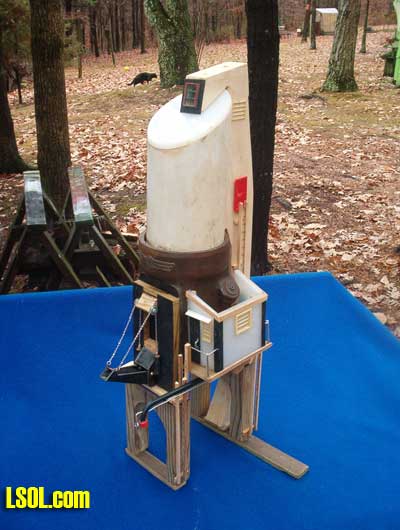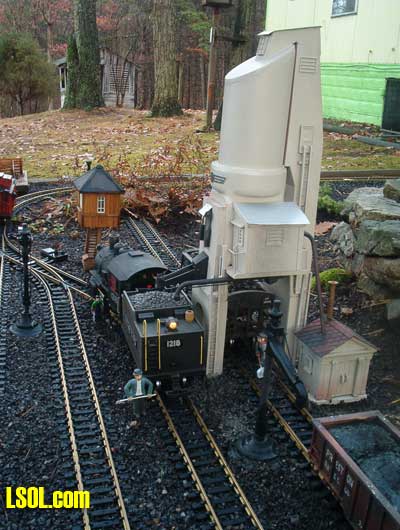Scratch & Bash
:
Buildings
Making a Coaling Stations for a Steam-Operated Railroad.
Feb 18, 2009


By Kirke Fay |
Author
Bio
Once a common sight on almost any steam-operated railroad, coaling stations or coaling docks were a necessary part of locomotive servicing. The basic idea is that the coal is delivered directly to the underside of the dock, most commonly by a track on the side where a hopper would dump the load of coal.
|
Once a common sight on almost any steam-operated railroad, coaling stations or coaling docks were a necessary part of locomotive servicing. The basic idea is that the coal is delivered directly to the underside of the dock, most commonly by a track on the side where a hopper would dump the load of coal. It would then be hoisted into the bin above and dropped by gravity into the tenders of the locomotives via a chute. The coal, after being dumped into a pit beneath the incoming track, was hoisted to the top of the coal dock by means of a skip hoist, which was a couple of large scoops that ran on continuous track on which the scoops were attached via a roller-coaster hookup. On most docks, on the scoop of coal reaching the top, the first step after the dump would be to enter a crusher that would break down any lumps too large for a fireman's scoop or an exit from the chute of the dock into the tender. After exiting the crusher, the coal would fall into the central bin, to be released by the hostler or fireman into the tender (after positioning the same beneath the chute). The counter-balanced chute would be pulled down into the tender, and a gate at the base of the bin would be pulled open and coal would commence falling out by way of gravity. Sand, used in traction, that had been dried in a nearby sandhouse, which usually had a stove for the purpose, would have been fed to an elevated hopper above the locomotive. It would have also been fed by gravity into the locomotives sand dome. I have included a small holding shed on the end of the coaling station in this model, as well as a sanding house on the ground level with a connecting pipe between the two structures.
The basic surprise part of this coaling station/dock is that the central part is from a once common farm implement, a cream separator, in this case, one made in the past by Montgomery Ward. I've paid homage, in this case, to Montgomery Ward by leaving the brass builders plate on the front of the coal station. 
The cast iron base like the lighthouse project, was tossed into the weeds some years ago, and has lost it's working parts, being a large funnel shaped top with two spouts that rust reclaimed over the years. Nonetheless, I'ts size and critical dimensions worked out perfect to a large scale size, (though best on a 1/29 or 1/24 scale) because the distance between the two legs is 4 inches. In creating this piece of whimsey. I have tried to deliver the visual message, that "Oh yeah, I remember that large cement tower down by the roundhouse" As you can see I have constructed this to receive the coal beneath, and the locomotive to be serviced on the outside track. The reasoning will follow, if you'll bear with me... As they say, no commercial parts were harmed in making this project. The parts were all at hand, and if you include "borrowing" your grand-daughters play necklace, and removing a 1/4 round plastic coathanger from the closet without detection, all the better....
Plasticville "O" and "HO" rements of buildings, as well as large-spaced hardware cloth sandwiched between two grooved pieces of wood to make ladders from, some scrap 3/4 scrap lumber, and most surprising, the thick plastic frame of a power-washer, as in clean your deck with, that was cut down on the bandsaw to make the parts for the coal chutes. This was a challenging yet fun part, as the chute is at an angle, which meant that the part it had to fit into was a little larger, and being that there are no joints, there is no danger of coming apart in the future from the weather. The chains (the grand-daughters necklace) that run to the counterbalances (ball point pen body, cut in half) drape over and in between wood screws with washers and a short piece of plastic hose as a spacer. The overall height of this structure is 22 inches, and the space beneath is 4 inches across, and made 7 inches tall by adding two legs that are the "cement" supports for the bottom of the coal station, and atop this is a piece of 4 1/2 inch wide PCV pipe as the coal bunker. The delivery unit, attached to the roof and sides is from a 2x4 inch piece of wood, cut on the bandsaw to fit. Windows and an access door are Plasticville parts, glued directly to the structure, and painted over. Now, the space beneath being 4 inches wide, is going to limit the size of cars or engines going beneath to say, 3 3/4 inches wide. My LGB #1218 will just fit, with a width of 3 7/8 because of the handrails on the cab. #7, a tank engine will do just fine at 3 3/4 wide. Now please refer to picture which is the stucture yet to be painted, and perhaps you may be able to pick out all these parts mentioned above. 
The sandhouse is yet to be added, and is in final photo. It is an "HO" gauge church, with the side walls cut short and covered by "O" scale plastic brick material...the front doors were cut out and a new entrance door fastened in as a replacement. There is the formentioned coathanger, running up to the holding area for the sand, and also the rest of the coathanger, becoming the sand-delivery pipe. (with a piece of aluminum wire supporting it beneath).  Here is an overall view of the in place coal station/dock as seen in the yard of the railroad. Note the water standpipe, which has been covered in another "How to" story, located so as to make a one stop servive area. A few 12 volt lights will be added in the future to illuminate this building at night. What I have done, is awakening your "inner genius" to view common objects as potential parts to fool the eye and amuse your visitors, as well as give you inspiration for projects that cost next to nothing, but time and pleasure.
| Great work! |
| Your work is wonderful! We do not have to slavishly follow prototype and put every rivet in place and measure every brick and piece of lumber. You give free rein to your inagination and have a great time making ingenious parts for your model railroad. You are an inspiration! Thank you. |
| Stephen Auslender - 02/18/2009 - 09:28 |
| More Ingenuity |
| Kirke, Once again a great use of an item no one would think to use as a central component of a coaling tower. I always enjoy your articles and pick up ideas that can be applied on the CD&StL. Well, so much for fresh cream for the coffee. Guess I'll have to switch to that fake stuff!!!!!! |
| JD Miller - 02/18/2009 - 11:02 |
| Coaling Station |
| Kirke: Great job. I can remember as a kid helping my Dad on the C&S put up coal in the chutes at Cheyenne and Chugwater. It was always an exciting experience to be around the coal chute while either putting up coal or taking on coal with the fireman or hostler. Jim |
| Jim O'Connor - 02/18/2009 - 16:33 |
| Coaling Station |
| OK, so a coal bin dropped delivered coal directly down below railcar, and then elevated it up to top bin where it was delivered by side chute to tenders? I have never actually seem one of these, too young and oil was the norm in my time, now diesel is the norm. |
| KC - 02/24/2009 - 08:30 |
Top of Page
|



